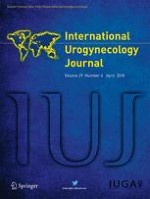Erschienen in:

08.08.2017 | Original Article
Effect of pulsed magnetic stimulation on quality of life of female patients with stress urinary incontinence: an IDEAL-D stage 2b study
verfasst von:
Renly Lim, Men Long Liong, Wing Seng Leong, Nurzalina Abdul Karim Khan, Kah Hay Yuen
Erschienen in:
International Urogynecology Journal
|
Ausgabe 4/2018
Einloggen, um Zugang zu erhalten
Abstract
Introduction and hypothesis
We evaluated the effects of pulsed magnetic stimulation (PMS) on overall and different aspects of quality of life (QoL) in female patients with stress urinary incontinence (SUI).
Methods
This study involved 120 female SUI subjects aged ≥21 years old randomized to either active or sham PMS. Treatment involved two PMS sessions per week for 2 months (16 sessions). After 2 months, subjects could opt for 16 additional sessions regardless of initial randomization. The primary response criterion was a 7-point reduction in the total score of the International Consultation on Incontinence Questionnaire-Lower Urinary Tract Symptoms Quality of Life (ICIQ-LUTSqol) questionnaire. Follow-ups were conducted at months 1, 2, 5, 8, and 14.
Results
At 2 months, 35 out of 60 (58%) subjects in the active arm and 21 out of 60 (21%) in the sham arm were treatment responders (≥7-point reduction) (p = 0.006). There was a significant difference in changes in the mean ± SE ICIQ-LUTSqol total score between the active and sham arms (Mdiff = −8.74 ± 1.25 vs −4.10 ± 1.08, p = 0.006). At 1-year post-treatment, regardless of number of PMS sessions (16 or 32 sessions), subjects who received active PMS (63 out of 94, 67%) were more likely to be treatment responders compared with subjects who did not receive any active PMS (3 out of 12, 25%; p < 0.001). The impact of PMS treatment was the greatest on the “physical activities” domain.
Conclusions
PMS resulted in significant short- and long-term improvements in overall and various physical, social, and psychological aspects of QoL.











